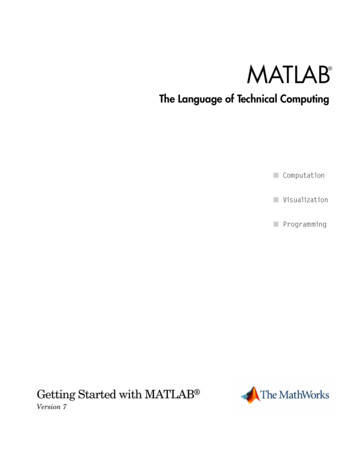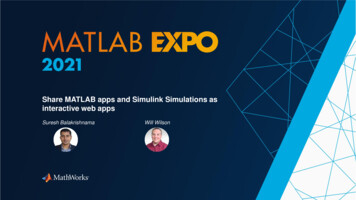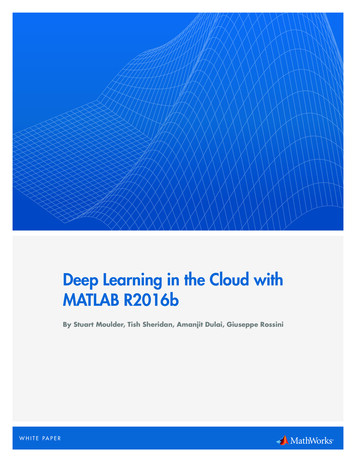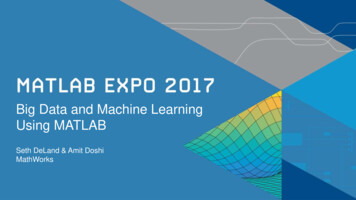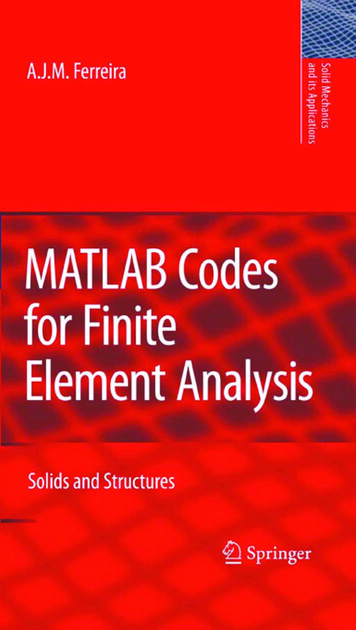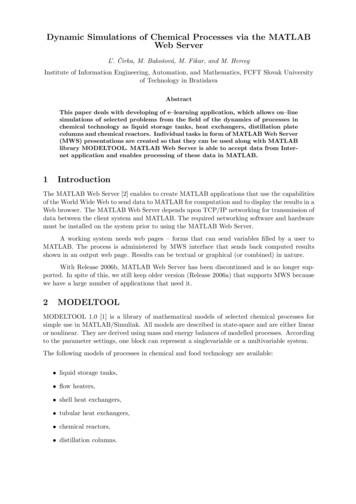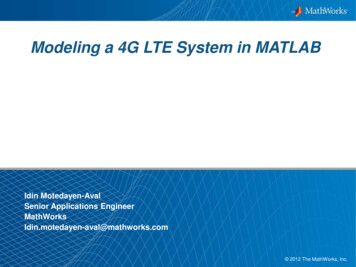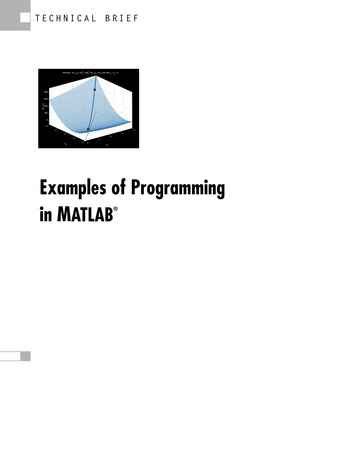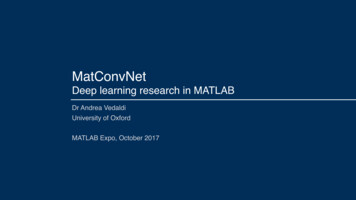
Transcription
Deep Learning with MATLABand Multiple GPUsBy Stuart Moulder, Tish Sheridan, Pietro Cavallo, and Giuseppe RossiniW H I T E PA P E R
Deep Learning with MATLAB and Multiple GPUsIntroductionYou can use MATLAB to perform deep learning with multiple GPUs. Using multiple GPUs to train asingle model provides greater memory and parallelism. These additional resources afford you largernetworks and datasets; and for models which take hours or days to train, could save you time.Deep learning is faster when you can use high-performance GPUs for training. If you don't have asuitable GPU available, you can use the new Amazon EC2 P2 instances to experiment. P2 instancesare high-specification multi-GPU machines. You can use deep learning on machines with a singleGPU, and later scale up to 8 GPUs per machine to accelerate training, utilizing parallel computing totrain a large, neural network with all of the processing power available.Use the following sections to learn: How to train, test, and evaluate neural networks for deep learning problems in MATLAB How to scale up deep learning using high-performance multi-GPU machines in theAmazon Web Services cloudDeep Learning in MATLABDeep learning is a branch of machine learning that teaches computers to do what comes naturally tohumans and animals: learn from experience. Machine learning algorithms use computational methods to “learn” information directly from data without relying on a predetermined equation as amodel. Deep learning is especially suited for image recognition, which is important for solving problems such as face recognition, motion detection, and advanced driver assistance technologies (such asautonomous driving, lane detection, and autonomous parking).Deep learning uses neural networks to learn useful representations of features directly from data.Neural networks combine multiple nonlinear processing layers, using simple elements operating inparallel, inspired by biological nervous systems. Deep learning models can achieve state-of-the-artaccuracy in object classification, sometimes exceeding human-level performance. You can trainmodels using a large set of labeled data and neural network architectures that contain many layers,usually including some convolutional layers. Training these models is computationally intensive; youcan usually accelerate training by using high-specification GPUs.W H I T E PA P E R 2
Deep Learning with MATLAB and Multiple GPUsFigure 1: Example of an image classification model.For this paper, we use a well-known existing network called AlexNet (refer to ImageNet Classificationwith Deep Convolutional Neural Networks). AlexNet is a deep convolutional neural network (CNN),designed for image classification with 1000 possible categories. MATLAB has a built-in helper function to load a pre-trained AlexNet network:% Load the AlexNet networknetwork alexnet;If the required package does not exist, you will be prompted to install it using the MATLAB Add-onExplorer. Inspect the layers of this network using the Layers property:network.LayersTo learn more about any of the layers, refer to the Neural Network Toolbox documentation.The goal is to classify images into the correct class. For this paper, we created our own image datasetusing images available under a Creative Commons license. The dataset contains 96,000 color imagesin 55 classes. Here we show five random images from the first five classes.W H I T E PA P E R 3
Deep Learning with MATLAB and Multiple GPUsFigure 2: Example classes and images from our image dataset.We resize and crop each image to 227x227 to match the size of the input layer of AlexNet.Transfer LearningTraining a large network, such as AlexNet, requires millions of images and several days of computetime. The original AlexNet was trained over several days on a subset of the ImageNet dataset, whichconsisted of over a million labelled images in 1000 categories (refer to ImageNet: A Large-ScaleHierarchical Image Database). AlexNet has learned rich feature representations for a wide range ofimages. To quickly train the AlexNet network to classify our new dataset, we use a technique calledtransfer learning. Transfer learning utilizes the idea that the features a network learns when trainedon one dataset are also useful for other similar datasets. You can fix the initial layers of a pre-trainednetwork, and only fine-tune the last few layers to learn the specific features of the new dataset.Transfer learning usually results in faster training times than training a new CNN and enables use ofa smaller dataset without overfitting.The following code shows how to apply transfer learning to AlexNet to classify your own dataset.1. Load the AlexNet network and replace the final few classification layers. To minimize changes tothe feature layers in the rest of the network, increase the learning rate of the new fully-connectedlayer.W H I T E PA P E R 4
Deep Learning with MATLAB and Multiple GPUs% Load the AlexNet networknetworkOriginal alexnet;layersOriginal networkOriginal.Layers;% Copy all but the last 3 layerslayersTransfer layersOriginal(1:end-3);% Replace the fully connected layer with a higher learning ratelayersTransfer(end 1) ,.'BiasLearnRateFactor',20);% Replace the softmax and classification layerslayersTransfer(end 1) softmaxLayer();layersTransfer(end 1) classificationLayer();2. Create the options for transfer learning. Compared to training a network from scratch, you can seta lower initial learning rate and train for fewer epochs.% Define the transfer learning training optionsoptionsTransfer ropFactor',0.1,.'LearnRateDropPeriod',20);3. Supply the set of labelled training images to imageDatastore, specifying where you have savedthe data. You can use an imageDatastore to efficiently access all of the image files.imageDatastore is designed to read batches of images for faster processing in machine learningand computer vision applications. imageDatastore can import data from image collectionsthat are too large to fit in memory.W H I T E PA P E R 5
Deep Learning with MATLAB and Multiple GPUs% Define the training dataimdsTrain lders',true,.'LabelSource','foldernames');The dataset images are split into two sets: one for training, and a second for testing. The training setin this example is in a local folder called 'imageDataset/train'.4. To train the network use the trainNetwork function:net fer);The result is a fully-trained network which can be used to classify your new dataset.Test the NetworkAfter you create a fully-trained network, you can use it to classify a new set of images and measurehow accurate it is. The following code tests the accuracy of classification using the test set of imageslocated in a local folder called 'imageDataset/test'. The accuracy score is the percentage of correctlyclassified images using the test set.% Define the testing dataimdsTest ders',true,.'LabelSource','foldernames');% Measure the accuracyyTest classify(net,imdsTest);accuracy sum(yTest imdsTest.Labels) / numel(imdsTest.Labels);W H I T E PA P E R 6
Deep Learning with MATLAB and Multiple GPUsTraining with Multiple GPUsCutting-edge neural networks rely on increasingly large training datasets and networks structures. Inturn, this requires increased training times and memory resources. To support training such networks, MATLAB provides support for training a single network using multiple GPUs in parallel.Depending on your network and dataset, this can provide the following benefits.Increased GPU MemoryConvolutional neural networks are typically trained iteratively using batches of images. This is donebecause the whole dataset is far too big to fit into GPU memory. The optimal batch size depends onthe exact network and dataset in question, so you need to experiment. Too large a batch size can leadto slow convergence, while too small a batch size can lead to no convergence at all. Often the batchsize is dictated by the GPU memory available. For larger networks, the memory requirements perimage increases and the maximum batch size is reduced.When training with multiple GPUs, each image batch is distributed between the GPUs. This effectively increases the total GPU memory available, allowing larger batch sizes. Depending on yourapplication, a larger batch size could provide better convergence or classification accuracy.Reduced Training TimeUsing multiple GPUs can provide a significant improvement in performance. When deciding if youexpect multi-GPU training to deliver a performance gain, consider the following factors: How long is the iteration on each GPU? If each GPU iteration is short, the added overhead of communication between GPUs can dominate. Try increasing the computation per iteration by using alarger batch size. Are you using more than 8 GPUs? Communication between more than 8 GPUs on a singlemachine introduces a significant communication delay. Are all the GPUs on a single machine? Communication between GPUs on different machinesintroduces a significant communication delay.By default, the trainNetwork function uses a GPU (if available), otherwise the CPU is used. If youhave more than one GPU on your local machine, enable multiple GPU training by setting the'ExecutionEnvironment' option to 'multi-gpu' in your training options. As discussed above, you mayalso wish to increase the batch size and learning rate for better convergence and/or performance.W H I T E PA P E R 7
Deep Learning with MATLAB and Multiple GPUs% Define the multi-gpu training optionsoptionsTransfer Environment','multi-gpu');If you do not have multiple GPUs on your local machine, you can use Amazon EC2 to lease a multiGPU cloud cluster.Scale Up to Deep Learning in the CloudHaving performed transfer learning on one desktop computer, you now want to make use of a highspecification multi-GPU machine. Amazon can provide suitable machines on demand, using theirnew P2 instances. The new Amazon EC2 P2 instances are machines specifically designed for compute-intensive applications, providing up to 16 NVIDIA Tesla K80 GPUs per machine. In the following sections, you can learn how to reserve a P2 instance, connect to the data, and train a model inparallel using multiple GPUs in the cloud.To use deep learning in the cloud, you need: MATLAB, Neural Network Toolbox, Parallel Computing Toolbox A MathWorks account Access to MATLAB Distributed Computing Server for Amazon EC2 An Amazon Web Services accountConnecting to Amazon EC2 Using MathWorks Cloud CenterAmazon Elastic Compute Cloud (Amazon EC2) is a web service which you can use to set up computecapacity in the cloud. Amazon EC2 is ideally suited for intensive computational demands and largedatasets found in deep learning. By using Amazon EC2, you can economically scale up your computing resources and gain access to domain-specific hardware. You can use a single GPU to take advantage of the parallel nature of neural networks, dramatically reducing the time required to train asingle model. You can use multiple GPUs to train larger models in less time. You can scale up beyondthe desktop, and scale in a flexible way without requiring any long-term commitment.W H I T E PA P E R 8
Deep Learning with MATLAB and Multiple GPUsMathWorks Cloud Center is a web application for creating and accessing compute clusters in theAmazon Web Services cloud for parallel computing with MATLAB. You can access a cloud clusterfrom your client MATLAB session, like any other cluster in your own onsite network. To learn more,refer to MATLAB Distributed Computing Server for Amazon EC2. To set up your credentials andcreate a new cluster, refer to Create and Manage Clusters in the Cloud Center documentation.In the following example, we create a cluster of a single machine with 8 GPUs and 8 workers. Settingthe number of workers equal to the number of GPUs ensures there is no competition between workersfor GPU resources. The main steps are:1. Log in to Cloud Center using your MathWorks email address and password.2. Click User Preferences and follow the on-screen instructions to set up your Amazon Web Services(AWS) credentials. For help, refer to the Cloud Center documentation:Set Up Your Amazon Web Services (AWS) Credentials.3. To create a cluster of Amazon EC2 instances, click Create a Cluster.4. Complete the following steps, and then ensure your settings look similar to the screenshot below.a. Name the clusterb. Choose an appropriate Regionc. Select Machine Type: Double Precision GPU (p2.8xlarge, 16 core, 8 GPU)d. For Number of Workers, select 8e. Leave the other settings as defaults and click Create ClusterFigure 3: Cloud Center: Create a cluster with multiple GPUs.W H I T E PA P E R 9
Deep Learning with MATLAB and Multiple GPUs5. To access your cluster from MATLAB, on the home tab select Parallel Discover Clusters tosearch for your Amazon EC2 clusters. When you select the cluster, the wizard automatically sets itas your default cluster.Confirm your cluster is online: either from Cloud Center, or from within MATLAB by creating acluster instance and displaying the details:cluster parcluster();disp(cluster);By default, if the cluster is left idle for too long, it automatically shuts down to avoid incurringunwanted expense. If your cluster has shut down, bring it back online either by clicking Start Up inCloud Center, or typing start(cluster); in MATLAB:start(cluster);After your cluster is online, query the GPU device of each worker:wait(cluster)spmddisp(gpuDevice());endThis returns details of the GPU device visible to each worker process in your cluster. The spmd blockautomatically starts the workers in a parallel pool, if you have default preferences. The first time youcreate a parallel pool on a cloud cluster can take several minutes.You can start or shut down the parallel pool using the Parallel Pool menu in the bottom left of theMATLAB desktop.To learn more about using parallel pools, refer to the Parallel Pools documentation.W H I T E PA P E R 10
Deep Learning with MATLAB and Multiple GPUsTraining with a GPU ClusterTo enable training on a compute cluster, set the 'ExecutionEnvironment' option to 'parallel' in yourtraining options.% Define the parallel training optionsoptionsTransfer Environment','parallel');If no pool is open, trainNetwork will automatically open one using the default cluster profile. Ifthe pool has access to GPUs, then they will be used.When training on a cluster, the location passed to imageDatastore must exist on both the clientMATLAB and on the worker MATLAB. For this reason, we store our data in an Amazon S3 bucket.An S3 location is referenced by a URL, hence the path is visible on all machines. For more information on using data in S3, refer to Use Data in Amazon S3 Storage.Use Data in Amazon S3 StorageAmazon Simple Storage Service (S3) provides secure and scalable storage in the cloud. Once data isuploaded to Amazon S3, it can be accessed from anywhere, making it ideally suited for distributingmachine learning datasets to cloud clusters. We uploaded our training and test images stored locallyin the 'imageDataset' folder to an S3 bucket of the same name. More information about uploading andaccessing data using S3 can be found in the Amazon S3 documentation.By default, objects stored in Amazon S3 are private and can only be accessed by their owner. Toaccess or modify these resources, the client must first have the correct authentication tokens. To generate these tokens, the resource owner can use the AWS Management Console to create anAccess Key ID and corresponding Secret Access Key. Clients who they share tokens with will thenhave programmatic access to their data stored in Amazon S3. Further details about generating accesskeys can be found in the Amazon Access Keys documentation.The following example demonstrates how you would configure your AWS authentication tokens asenvironment variables. Enter in your local MATLAB:W H I T E PA P E R 11
Deep Learning with MATLAB and Multiple GPUs% Set AWS credentials as environment variables on local client MATLABsetenv('AWS ACCESS KEY ID', 'AKIAIOSFODNN7EXAMPLE');setenv('AWS SECRET ACCESS KEY', .'wJalrXUtnFEMI/K7MDENG/nPxRiCYEXAMPLEKEY');To access training data, you now simply create an image datastore pointing to the URL of the S3bucket.% Define the Amazon S3 training dataimdsTrain Subfolders', true, .'LabelSource', 'foldernames');To access S3 resources from a cluster, you must set the same environment variables on your workers.The following code manually opens a parallel pool on your cloud cluster and copies the necessaryenvironment variables to the workers.% Set AWS credentials on all workersaws access key id getenv('AWS ACCESS KEY ID');aws secret access key id getenv('AWS SECRET ACCESS KEY');spmdsetenv('AWS ACCESS KEY ID',aws access key id);setenv('AWS SECRET ACCESS KEY',aws secret access key id);endThe workers now have access to the Amazon S3 resources for the lifetime of the parallel pool.ResultsHaving used Mathworks Cloud Center and Amazon EC2 to lease a multi-GPU compute cluster, wewould now like to investigate the performance benefits which this affords. The following plot showsthe classification accuracy of our network as a function of training time. The classification accuracyis defined as the accuracy achieved by the network on the mini batch of images for the current training iteration. The training was repeated four times, each using a different number of GPUs to trainthe network in parallel. As discussed in Increased GPU Memory, training across more GPUs permitsW H I T E PA P E R 12
Deep Learning with MATLAB and Multiple GPUsa larger image batch size. We therefore scale the image batch size with the number of GPUs to fullyutilize the available memory. To normalize the learning rate per epoch, we also scale the learning ratewith the image batch size, because a larger batch size provides fewer iterations per epoch.Figure 4: Training convergence with varying numbers of GPUs.These results show that the additional memory and parallelism of more GPUs can provide significantly faster training. Smoothing out the data, we find that the time taken to reach a classificationaccuracy of 95% decreases by approximately 30-40% with each doubling of the number of GPUs usedto train. This reduces the training time to around 10 minutes when using 8 GPUs, compared to morethan 40 minutes with a single GPU.To further quantify these results, we plot the average image throughput, to normalize for the differentbatch sizes. This shows an increase in the number of images processed per unit time of approximately70% with each doubling of the number of GPUs.W H I T E PA P E R 13
Deep Learning with MATLAB and Multiple GPUsFigure 5: Image throughput with varying numbers of GPUs.Using a separate dataset of test images, we measure the classification accuracy of our networks onunseen images. The four networks trained with different numbers of GPUs all achieve an accuracy of87%, to within half a percent.To see the script for training AlexNet with your own data using a multi-GPU cluster, seeAppendix – MATLAB code.Note: Creating a cluster and parallel pool in the cloud can take up to 10 minutes. For the small problem analyzed in this paper, this was a significant proportion of the total time. For other problemswhere the total training time can take hours or days, this cluster startup time becomes negligible.ConclusionsIn this paper, we show how you can use MATLAB to train a large, deep neural network. The codeprovides a worked example; demonstrating how to train a network to classify images, use it to classifya new set of images, and measure the accuracy of the classification. Using Mathworks Cloud Centerwith Amazon EC2 to lease a multi-GPU compute cluster, we demonstrate a significant reduction intraining time by distributing the work across multiple GPUs in parallel. For large datasets, such a performance increase can save hours or days.W H I T E PA P E R 14
Deep Learning with MATLAB and Multiple GPUsUseful links:For more information, see the following resources: htmlCentral resource for Deep Learning with MATLAB neural-networks.htmlNeural Network Toolbox documentation on essential tools for deep learning ing/parallel-computing-on-the-cloud/ https://aws.amazon.com/console/Appendix – MATLAB CodeThe following MATLAB code uses transfer learning to train AlexNet on a new image dataset stored inAmazon S3 using a cluster. To run this script, use your own Amazon S3 bucket and set the appropriateenvironment variables for your Amazon Access key.% Number of workers to train with. Set this number equal to the number of% GPUs on you cluster. If you specify more workers than GPUs, the remaining% workers will be idle.numberOfWorkers 8;% Scale batch size with expected number of GPUsminiBatchSize 250 * numberOfWorkers;% Scale learning rate with batch sizelearningRate 0.00125 * numberOfWorkers;%% Load the AlexNet networknetworkOriginal alexnet;layersOriginal networkOriginal.Layers;% Copy all but the last 3 layerslayersTransfer layersOriginal(1:end-3);% Replace the fully connected layer with a higher learning rateW H I T E PA P E R 15
Deep Learning with MATLAB and Multiple GPUs% The output size should be equal to the number of labels in yourdataset.layersTransfer(end 1) ,.'BiasLearnRateFactor',20);% Replace the softmax and classification layerslayersTransfer(end 1) softmaxLayer();layersTransfer(end 1) classificationLayer();%% Start a parallel pool if one is not already openpool gcp('nocreate');if isempty(pool)parpool(numberOfWorkers);elseif (pool.NumWorkers rs);end%% Copy local AWS credentials to all workersaws access key id getenv('AWS ACCESS KEY ID');aws secret access key id getenv('AWS SECRET ACCESS KEY');spmdsetenv('AWS ACCESS KEY ID',aws access key id);setenv('AWS SECRET ACCESS KEY',aws secret access key id);end%% Load the training and test dataimds ders',true, .'LabelSource','foldernames');W H I T E PA P E R 16
Deep Learning with MATLAB and Multiple GPUs%% Shuffle and split data into training and testing[imdsTrain,imdsTest] splitEachLabel(shuffle(imds),0.9);%% Define the transfer learning training optionsoptionsTransfer allel');%% Train the network on the clusternet fer);%% Record the accuracy for this network% Uses the trained network to classify the test images on the local machine% and compares this to their ground truth labels.YTest classify(net,imdsTest);accuracy sum(YTest imdsTest.Labels)/numel(imdsTest.Labels); 2017 The MathWorks, Inc. MATLAB and Simulink are registered trademarks of The MathWorks, Inc. See mathworks.com/trademarks for a list of additional trademarks.Other product or brand names may be trademarks or registered trademarks of their respective holders.W H I T E PA P E R 1703/17
Amazon Web Services cloud for parallel computing with MATLAB. You can access a cloud cluster from your client MATLAB session, like any other cluster in your own onsite network. To learn more, refer to MATLAB Distributed Computing Server for Amazon EC2. To set up your credentials and create a new cluster, refer to Create and Manage Clusters in .

